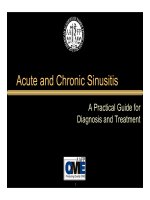Acute and Chronic Sinusitis - A Practical Guide for Diagnosis and Treatment docx
Bạn đang xem bản rút gọn của tài liệu. Xem và tải ngay bản đầy đủ của tài liệu tại đây (509.58 KB, 81 trang )
1
Acute and Chronic Sinusitis
A Practical Guide for
Diagnosis and Treatment
2
0031003
Presentation Facts
• File size: approximately 2013 KB
• Number of slides: 81
• Evidence-Based CME: Web site addresses for all EB
recommendations are available near the end of this presentation
• These slides were prepared by the AAFP and content should
not be modified in any way. If content is changed, it is the
user’s responsibility to remove both the AAFP and the
CME logos.
Instructions to remove logos: from menu, select VIEW, MASTER, SLIDE
MASTER; select the logos and delete; to return to the original slide view, select
VIEW, SLIDE
3
0031003
Acknowledgments
This is a presentation of the
American Academy of Family Physicians
supported by an educational grant from
Aventis Pharmaceuticals
The AAFP gratefully acknowledges
Harold H. Hedges, III, M.D.
and
Susan M. Pollart, M.D.
for developing the content for the AAFP
and
Harold H. Hedges, III, M.D. for providing the
photo images included in this slide presentation.
4
0031003
Acknowledgments
Harold H. Hedges, III, M.D.
Private Practice
Little Rock Family Practice Clinic
Little Rock, Arkansas
and
Susan P. Pollart, M.D.
Associate Professor of Family Medicine
University of Virginia Health System
Charlottesville, Virginia
5
0031003
Upon Completion of This Presentation
You Should be Able To
• Be knowledgeable of the causes of and risk factors associated
with sinusitis
• Differentiate acute from chronic sinusitis
• Evaluate patients by history, physical exam, appropriate
laboratory and imaging studies, and when indicated screen
patients for allergy
• Prescribe appropriate medication regimens for acute and
chronic sinusitis
• Know of the relationships between upper airway
(rhinosinusitis) and lower airway disease (asthma)
6
0031003
Rhinosinusitis May be Better Term Because
• Allergic or nonallergic rhinitis nearly always precedes sinusitis
• Sinusitis without rhinitis is rare
• Nasal discharge and congestion are prominent symptoms of
sinusitis
• Nasal mucosa and sinus mucosa are similar and are contiguous
7
0031003
Scope of Sinusitis
• Affects 30-35 million persons/year
• 25 million office visits/year
• Direct annual cost $2.4 billion and increasing
• Added surgical costs: $1 billion
• Third most common diagnosis for which antibiotics are
prescribed
8
0031003
Normal Sinus
• Sinus health depends on:
– Mucous secretion of normal viscosity, volume, and
composition,
– normal mucociliary flow to prevent mucous stasis and
subsequent infection;
– and open sinus ostia to allow adequate drainage and aeration.
• Senior BA, Kennedy DW. Management of sinusitis in the
asthmatic patient AAAI J,1996;77:6-19.
9
0031003
Development of Sinuses
• Maxillary and ethmoid sinuses present at birth
• Frontal sinus developed by age 5 or 6
• Sphenoid sinus last to develop, 8-10
10
0031003
Physiologic Importance of Sinuses
• Provide mucus to upper airways
– Lubrication
– Vehicle for trapping viruses, bacteria, foreign material for
removal
• Give characteristics to voice
• Lessen skull weight
• Involved with olfaction
11
0031003
Sinusitis
•
4 paranasal sinuses, each lined with pseudostratified
ciliated columnar epithelium and goblet cells
– Frontal
– Maxillary
– Ethmoid
– Sphenoid
Infectious or noninfectious inflammation of 1 or more sinuses
12
0031003
Normal Water’s and Towne’ s Views
of the Sinuses
13
0031003
Lateral View Showing Normal
Sphenoid Sinus
14
0031003
Ostiomeatal Complex
• Ostiomeatal complex is that area under the middle meatus
(airspace) into which the anterior ethmoid, frontal and
maxillary sinuses drain
• Posterior ethmoids drain into the upper meatus
• Ostiomeatal complex is the functional relationship between
the space and the ostia that drain into it
15
0031003
Viral Rhinosinusitis
• Most upper respiratory infections are viral
• Short lived, last less than 10 days
• Sinus mucosa as well as nasal mucosa is involved
• Most will clear without antibiotics
• Treatment: decongestants, nasal lavage, rest, fluids
16
0031003
Classification of Bacterial Sinusitis
• Acute bacterial sinusitis- infection lasting 4 weeks,
symptoms resolve completely (children 30 days)
• Subacute bacterial sinusitis
- infection lasting between 4 to
12 weeks, yet resolves completely (children 30-90 days)
• Chronic sinusitis
- symptoms lasting more than 12 weeks
(children >90 days)
• Some guidelines add treatment failure + a positive imaging
study
17
0031003
Recurrent Acute Bacterial Sinusitis
• Episodes lasting fewer than 4 weeks and separated by
intervals of at least 10 days during which the patient is
totally asymptomatic
• 3 episodes in 6 months or 4/year
18
0031003
Acute Sinusitis Imposed on
Chronic Sinusitis
• Patients with chronic, low grade symptoms experience
increase in mucous flow, change in viscosity or color, or
secretions
• Treated
• New symptoms resolve but chronic symptoms continue
19
0031003
Differentiating Sinusitis from Rhinitis
Sinusitis
Nasal congestion
Purulent rhinorrhea
Postnasal drip
Headache
Facial pain
Anosmia
Cough, fever
Rhinitis
Nasal congestion
Rhinorrhea clear
Runny nose
Itching, red eyes
Nasal crease
Seasonal symptoms
20
0031003
Road to Bacterial Sinus Infections
• Obstruction of the various ostia
• Impairment in ciliary function
• Increased viscosity of secretions
• Impaired immunity
• Mucus accumulates
• Decrease in oxygenation in the sinuses
• Bacterial overgrowth
21
0031003
X-Ray Image of Sinuses with
Maxillary Sinusitis
22
0031003
Pathogenesis of Nasal Obstruction
• Viral upper respiratory infections
– Daycare centers
• Allergic and nonallergic stimuli
• Immunodeficiency disorders
– Immunoglobulin deficiency (IgA, IgG)
• Anatomic changes
– Deviated septum, concha bullosa, polyps
23
0031003
Allergic Stimuli Causing Rhinosinusitis
• Pollens
– Tree, grass, weeds
• House dust mite
• Animal danders
– Cat, dog, mice, gerbil, other animals with fur
• Molds
• Allergic foods and beverages
24
0031003
Nonallergic Stimuli Causing Rhinosinusitis
• Tobacco smoke
• Perfumes
• Cleaning solutions
• Potpourri
• Burning candles
• Cosmetics
• Car exhaust, diesel fumes
• Hair spray
• Cold air
• Dry air
• Changes in barometric
pressure
• Auto exhaust
• Gas, diesel fuel
• Nonallergic foods
• Nonallergic beverages
25
0031003
Causes of Ciliary Dysfunction
• Immotile cilia syndrome
• Prolonged exposure to cigarette smoke
• Common cold viruses causing URI
• Increased viscosity of mucus
• Medications
– First generation antihistamines (non sedating do not affect)
– Anticholinergics
– Aspirin
– Anesthetic agents
– Benzodiazepines









